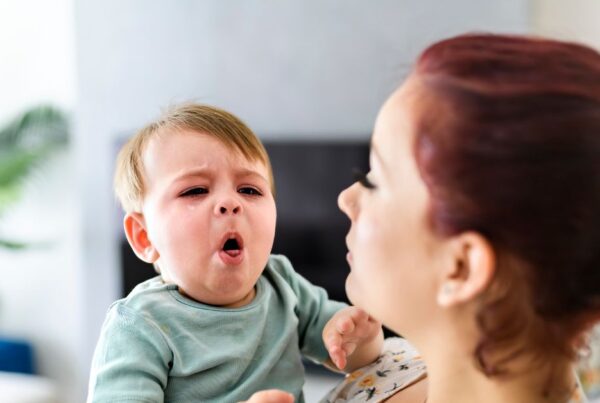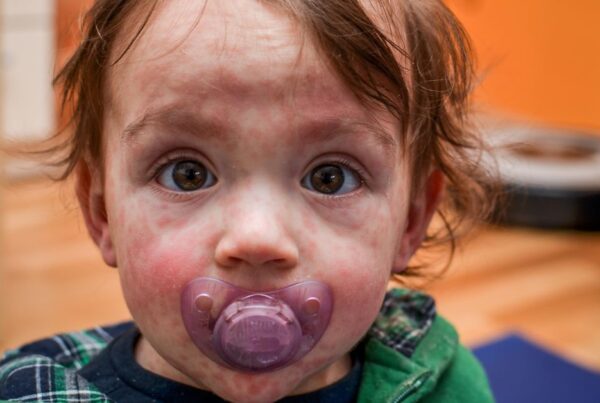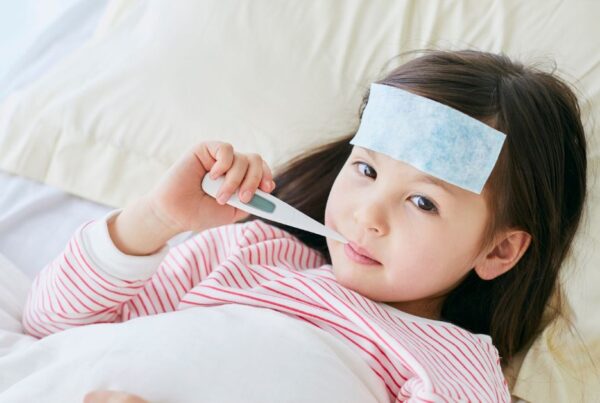Ringworm is a common skin infection in children. Despite the name, it has nothing to do with worms. This contagious fungal infection spreads easily through contact with people, animals, or contaminated surfaces. It can move quickly through classrooms, homes, and sports teams, which is why it’s important for parents to know what it looks like and how to treat it safely at home.
In this article, we’ll cover what causes ringworm, how to recognize it, which natural remedies may help, and when it’s time to call your healthcare provider.
What Is Ringworm?
Ringworm, or tinea corporis, is a fungal infection that lives on the surface of the skin. It’s caused by dermatophytes, a group of fungi that feed on keratin, the protein that helps form skin, hair, and nails (1). These fungi thrive in warm, moist environments and can survive on clothing, bedding, and household surfaces (1).
The infection typically causes a round red rash that often clears in the center, giving it the appearance of a ring. It may be mildly itchy or completely asymptomatic in the early stages, which makes it easy to miss.
Skin issues are common during childhood. To learn more, see: 8 Common Infant Skin Conditions
How Is Ringworm Different From Athlete’s Foot or Thrush?
While ringworm is one of the most well-known fungal infections in children, it’s not the only one. Two other common fungal infections include:
- Athlete’s foot (tinea pedis): Also caused by dermatophytes, but affects the feet, especially between the toes. Athlete’s foot is more common in older children, teens, and adults, particularly those who wear tight shoes or frequent locker rooms and pools.
- Thrush: Caused by a different type of fungus, Candida albicans. Thrush most often appears in the mouth, on the diaper area, or on nipples during breastfeeding. Unlike ringworm and athlete’s foot, thrush tends to occur when the immune system is weakened or after antibiotic use.
Although they affect different areas of the body, all three are fungal in nature and can be influenced by microbiome imbalance, excess moisture, and immune health.

How Ringworm Spreads
Ringworm is a highly contagious fungal infection that can spread quickly, especially in households with children, shared living spaces, or schools. It passes easily from person to person and can also be picked up from animals or contaminated surfaces.
It can spread through:
- Direct skin-to-skin contact with an infected person or animal
- Sharing personal items like towels, brushes, hats, or clothing
- Contact with contaminated surfaces in gyms, schools, or locker rooms
- Minor skin abrasions that allow fungi to enter more easily
- Excess moisture, such as sweaty clothing or not drying off properly after bathing
Children who play contact sports or live in close quarters with siblings are especially at risk.
The Skin Microbiome & Fungal Infections
The skin has its own microbiome—an ecosystem of bacteria, fungi, and other microbes that help protect it from infection (2). When the skin microbiome is balanced, it acts as a natural defense system. But certain factors, such as over-sanitizing, recent antibiotic use, or nutritional imbalances (3), can disrupt this balance and make it easier for fungal infections to take hold.
Supporting the skin’s microbiome with probiotic-rich foods, gentle hygiene practices, and nourishing topical care may help keep the skin barrier healthy.
To learn more about the microbiome, read this article: When Antibiotics Are Needed & How to Care for Your Microbiome

What Does Ringworm Look Like?
Ringworm can appear slightly different depending on the area of the body, but common signs include:
- Circular or oval red patches with raised scaly edges
- Clear or less inflamed skin in the center of the rash
- Mild to moderate itching
- Peeling, flaking, or cracked skin
- Hair loss in the affected area, especially with scalp infections
- Possible oozing or crusting in more advanced cases
It’s most often found on the trunk, arms, legs, and face. When it appears on the scalp (tinea capitis), it can cause round bald patches and may require prescription treatment.
Ringworm is sometimes confused with eczema. To learn about eczema, read this article: Eczema Treatment 101
Home Care & Hygiene Tips
Mild cases of ringworm can often be treated at home with consistent care and proper hygiene. Ringworm can be very contagious, so it is important to focus on containing the infection and reducing spread.
- Wash the affected area gently with soap and water a few times per day, and dry thoroughly.
- Avoid covering the rash unless necessary, since airflow supports healing.
- Wash clothing, bedding, and towels daily in hot water until the rash resolves.
- Disinfect shared surfaces and avoid sharing personal items.
- Check pets for signs of infection and consult a vet if needed.

Natural Remedies to Consider
While antifungal creams are often an essential part of treatment, natural remedies may offer additional support:
Tea Tree Oil
Combine a few drops with a carrier oil such as coconut oil and apply directly to the skin twice daily. Tea tree oil has known antifungal properties. If used in conjunction with antifungal cream, be sure to space out the application by a few hours.
Oral Probiotics
Daily probiotic use can help support the microbiome and skin health.
It is important to note that home remedies alone often are not always sufficient to resolve ringworm. If the ringworm does not improve with a few days of consistent homecare, it’s time to add over-the-counter antifungal creams or consult a doctor.
Over-the-Counter Antifungal Creams
Topical antifungal medications are generally safe and tend to be more effective than natural remedies when it comes to ringworm. Products containing clotrimazole (Lotrimin), terbinafine (Lamisil), or tolnaftate (Tinactin) can be found in most pharmacies.
To use antifungal cream:
- Clean and dry the skin before each application.
- Apply a thin layer to the rash and at least one inch beyond its edge.
- Continue using the cream for the full recommended duration, even if the rash appears to improve sooner.
- Always wash your hands after touching the area, as ringworm is contagious.
When to See a Doctor for Ringworm
Most ringworm cases resolve with consistent home treatment, but there are times when medical care is necessary. Call your provider if:
- The rash worsens or does not improve after two weeks
- The infection is on the scalp or nails, which typically require prescription antifungal treatment
- There is significant redness, swelling, pus, or pain, which may signal a secondary infection
- Multiple areas of the body are affected
- Your child is immunocompromised or has a history of recurrent fungal infection
- The affected person is a baby or young infant. Because infants have more delicate skin and immature immune systems, any suspected ringworm should be evaluated promptly by a pediatrician.
Summary
Ringworm is a common superficial fungal infection that spreads easily through contact with people, animals, or contaminated surfaces. It often appears as a scaly ring-shaped red rash and can usually be treated at home.
Restoring balance to the skin microbiome, practicing good hygiene, and knowing when to seek help are all part of a well-rounded approach. With early care and attention, most cases resolve quickly and without complications.
References:
- Yee G, Syed HA, Al Aboud AM. Tinea Corporis. [Updated 2025 Feb 14]. In: StatPearls [Internet]. Treasure Island (FL): StatPearls Publishing; 2025 Jan-. Available from: https://www.ncbi.nlm.nih.gov/books/NBK544360/
- Grice EA, Segre JA. The skin microbiome. Nat Rev Microbiol. 2011 Apr;9(4):244-53. doi: 10.1038/nrmicro2537. Erratum in: Nat Rev Microbiol. 2011 Aug;9(8):626. PMID: 21407241; PMCID: PMC3535073.
- Skowron K, Bauza-Kaszewska J, Kraszewska Z, Wiktorczyk-Kapischke N, Grudlewska-Buda K, Kwiecińska-Piróg J, Wałecka-Zacharska E, Radtke L, Gospodarek-Komkowska E. Human Skin Microbiome: Impact of Intrinsic and Extrinsic Factors on Skin Microbiota.


